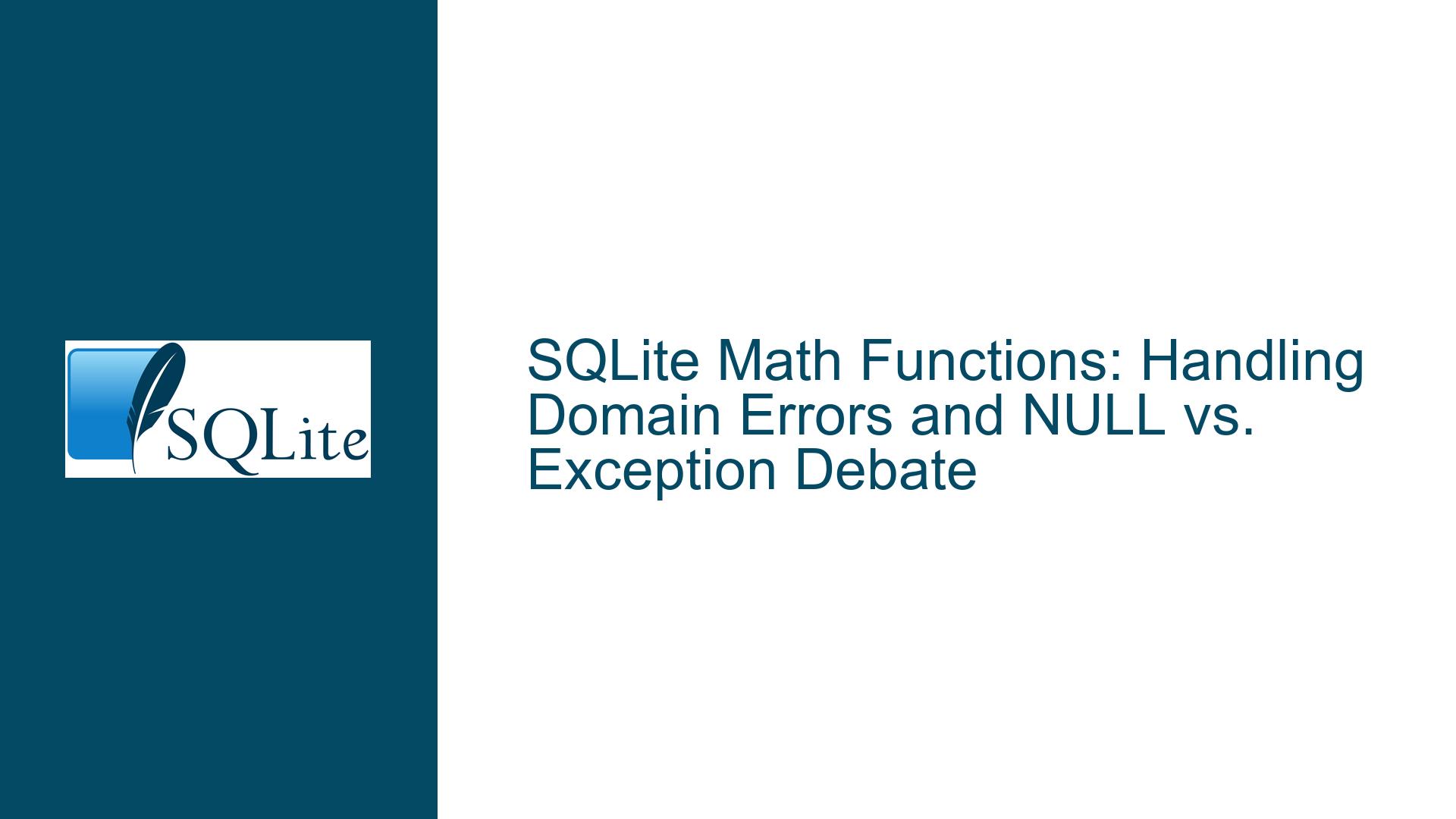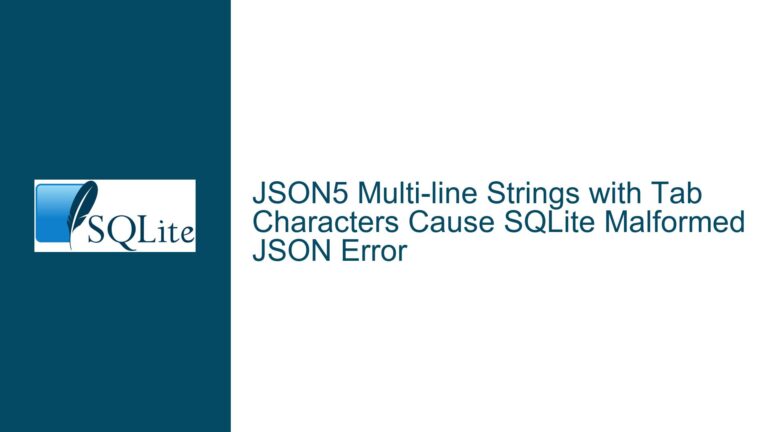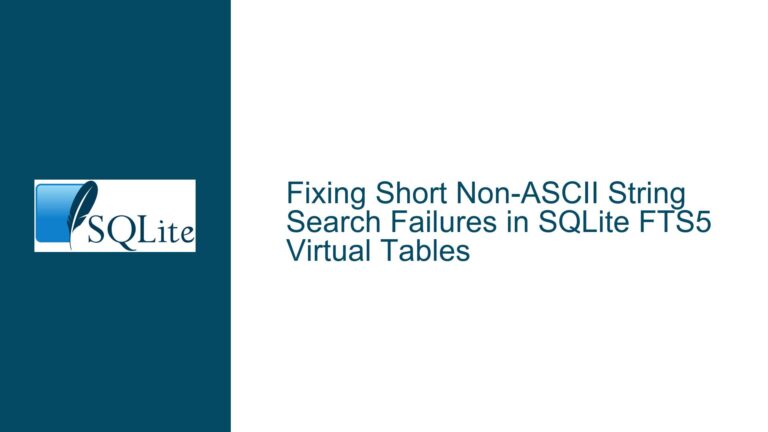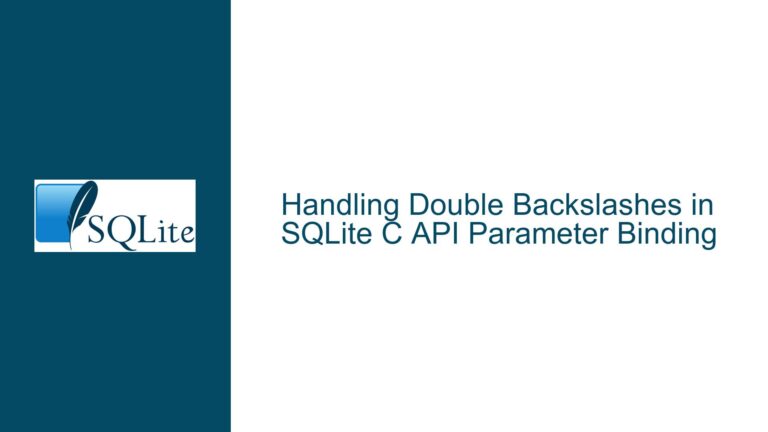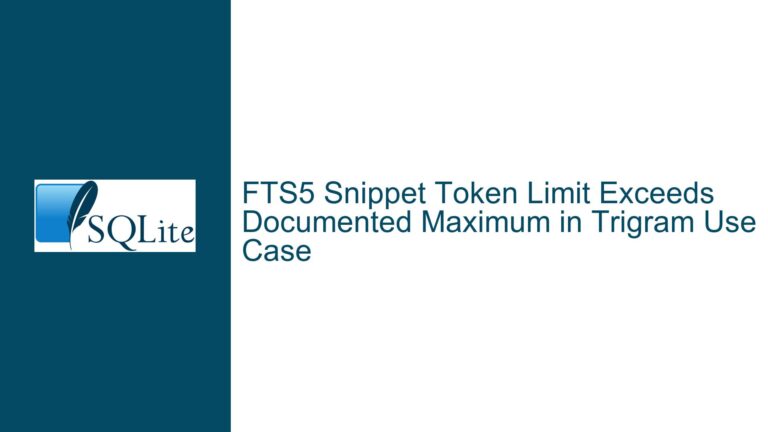SQLite Math Functions: Handling Domain Errors and NULL vs. Exception Debate
SQLite Math Functions Returning NULL for Invalid Arguments
SQLite’s implementation of mathematical functions such as SQRT(-1), LN(-1), and ACOS(2) returns NULL when the input arguments fall outside the valid domain. This behavior contrasts with the SQL Standard, which mandates that such cases should raise an exception. For example, the SQL Standard specifies that attempting to compute the natural logarithm of a zero or negative value should result in a "data exception — invalid argument for natural logarithm." Similarly, the square root of a negative number or the arc cosine of a value greater than 1 should also raise an error. However, SQLite opts to return NULL instead of throwing an exception, a design choice that has sparked debate among developers and database enthusiasts.
The rationale behind SQLite’s behavior lies in its pragmatic approach to error handling. By returning NULL, SQLite allows queries to continue processing without abrupt termination. This is particularly useful in scenarios where invalid inputs are expected and can be handled gracefully using functions like COALESCE() or IS NULL. However, this approach has its drawbacks. When NULL is returned unexpectedly, it can obscure the root cause of the issue, making debugging more challenging. For instance, if a query computes LN(-1) and receives NULL, the developer might spend considerable time tracing the source of the invalid input rather than immediately recognizing it as a domain error.
The debate extends beyond SQLite’s implementation to the broader question of how mathematical functions should handle invalid inputs. On one side, proponents of the SQL Standard argue that raising exceptions is the correct approach because it enforces data integrity and provides clear feedback when invalid operations are attempted. On the other side, advocates for SQLite’s behavior argue that returning NULL is more practical, as it allows for flexible error handling and avoids the need for complex exception-catching mechanisms in SQL.
Mathematical Validity and SQLite’s NULL Representation
The core of the issue lies in the mathematical validity of operations like SQRT(-1) and LN(-1). From a purely mathematical perspective, these operations do have solutions, but they lie outside the realm of real numbers. For example, the square root of -1 is an imaginary number, often represented as 1j in engineering contexts or i in mathematical contexts. Similarly, the natural logarithm of -1 is a complex number, specifically πi (or πj in engineering notation). However, SQLite, like most relational databases, operates exclusively within the domain of real numbers. As a result, it cannot represent these complex or imaginary values directly.
In such cases, the mathematically correct result is a "Not-a-Number" (NaN) value, which signifies that the operation cannot be represented within the constraints of the real number system. SQLite represents NaN values as NULL, which aligns with the behavior of many programming languages and database systems. This representation is not arbitrary; NULL in SQLite shares many properties with NaN, including propagation through arithmetic operations. For example, any arithmetic operation involving NULL results in NULL, just as operations involving NaN in floating-point arithmetic yield NaN.
Critics of SQLite’s approach argue that returning NULL for invalid mathematical operations is misleading because it conflates domain errors with missing or unknown data. In SQL, NULL is traditionally used to represent the absence of a value or an unknown state, not an invalid operation. By using NULL to represent domain errors, SQLite blurs this distinction, potentially leading to confusion. For instance, a query that computes LN(-1) and receives NULL might interpret the result as missing data rather than an invalid input, complicating debugging and data analysis.
Proponents of SQLite’s approach counter that the distinction between domain errors and missing data is less important in practice than the ability to handle errors gracefully. They argue that returning NULL provides a consistent and predictable way to handle invalid inputs, allowing developers to implement custom error-handling logic without relying on exception-catching mechanisms, which are not natively supported in SQLite. This flexibility is particularly valuable in scenarios where invalid inputs are expected and can be handled programmatically, such as in data cleaning or transformation pipelines.
Implementing Custom Error Handling with PRAGMA and Environment Variables
One potential solution to the debate is to introduce a configurable mechanism for handling domain errors in SQLite. This could be achieved through a PRAGMA statement or an environment variable, allowing developers to choose between returning NULL or raising an exception when invalid inputs are encountered. For example, a PRAGMA statement like PRAGMA math_error_handling = 'exception'; could instruct SQLite to raise an exception for domain errors, while PRAGMA math_error_handling = 'null'; would restore the default behavior of returning NULL.
This approach would provide the best of both worlds, allowing developers to adhere to the SQL Standard when necessary while retaining the flexibility of SQLite’s default behavior. It would also align with the practices of other programming languages and systems, such as Python and MATLAB, which allow users to configure error handling for mathematical operations. For instance, in Python, the numpy.seterr() function can be used to specify whether invalid operations should raise exceptions, return NaN, or issue warnings.
Another option is to introduce two-argument versions of mathematical functions, where the second argument specifies the desired behavior for invalid inputs. For example, LN(-1, 'exception') could raise an exception, while LN(-1, 'null') would return NULL. This approach would give query writers direct control over error handling, eliminating the need for system-wide configuration. However, it would also require modifying existing queries and views, which could be cumbersome in large codebases.
Regardless of the specific implementation, the key takeaway is that error handling in SQLite should be flexible and configurable. By providing developers with the tools to choose between returning NULL and raising exceptions, SQLite can accommodate a wide range of use cases and preferences, from strict adherence to the SQL Standard to pragmatic error handling in real-world applications.
Best Practices for Handling Invalid Mathematical Operations
When working with mathematical functions in SQLite, it is essential to adopt best practices for handling invalid inputs. These practices can help mitigate the challenges associated with SQLite’s default behavior while ensuring data integrity and facilitating debugging.
First and foremost, developers should validate input data before applying mathematical functions. This can be done using conditional logic in SQL queries or data cleaning routines in application code. For example, before computing the natural logarithm of a value, the query should check whether the value is greater than zero. If the value is invalid, the query can either skip the computation or apply a fallback value, such as NULL or a default constant.
Second, developers should use COALESCE() or IS NULL to handle NULL results gracefully. For example, a query that computes LN(column) can use COALESCE(LN(column), -1) to replace NULL results with a fallback value of -1. This approach ensures that invalid inputs do not disrupt query execution while providing a predictable result for downstream processing.
Third, developers should consider implementing custom error-handling logic using triggers or application code. For example, a trigger could be created to validate input data before it is inserted into a table, raising an exception if invalid values are detected. Similarly, application code can validate input data before executing SQL queries, ensuring that only valid inputs are processed.
Finally, developers should document their error-handling strategies and communicate them to stakeholders. This includes specifying whether NULL results indicate missing data or invalid inputs, as well as outlining the steps taken to validate input data and handle errors. Clear documentation can help prevent misunderstandings and ensure that all team members are aligned on error-handling practices.
By following these best practices, developers can navigate the complexities of SQLite’s mathematical functions and ensure robust, reliable, and maintainable database applications. Whether adhering to the SQL Standard or embracing SQLite’s pragmatic approach, the key is to prioritize data integrity, flexibility, and clarity in error handling.
